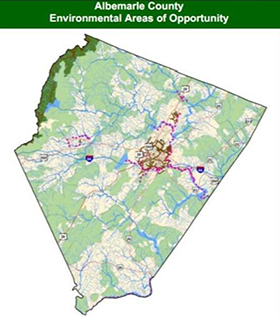Integrating Green Infrastructure and Transportation Planning

A page from the 2009
TJPDC Green Infrastructure Study. (Courtesy of TJPDC)
Thomas Jefferson Planning District Commission (Virginia)
| Total cost: |
$155,731 |
| FHWA share: |
$77,833 |
| Period of performance: |
36 months |
| Dates: |
May 20, 2008 – May 20, 2011 |
| Status: |
Complete |
| AOTR: |
Michael Lamprecht |
| Grant-project website: |
http://tjpdc.org/environment/ Content no longer available |
Project Goals
The goal of the Thomas Jefferson Planning District Commission (TJPDC) Eco-Logical project was to develop a green infrastructure plan that integrates transportation, development, and natural resource plans in the five-county planning district. The project team developed two GIS-based methodologies to help transportation planners prioritize mitigation projects for streams and wetlands.
Project Accomplishments
TJPDC staff created tools to help the metropolitan planning organization (MPO) and local governments to prioritize projects based on potential environmental impacts during the long range transportation planning (LRTP) process. Using methodologies they developed for stream and wetland prioritization, the TJPDC staff finalized a set of GIS maps that rank mitigation sites around the region at a detailed scale appropriate for project-level planning. One of the maps includes an overlay of proposed transportation projects so that agencies can prioritize projects based on potential impacts. TJPDC also created a “Least Environmental Cost Analysis” framework to use in developing alternatives in construction projects. TJPDC has provided its resulting Regional Ecosystem Framework (REF) to numerous local and State transportation and environmental agencies.
Future Steps
TJPDC continues to integrate the methodologies and maps of its Eco-Logical product into the region’s LRTP, which is expected to be adopted in 2014. As part of this effort, TJPDC is developing cost-benefit measures to compare projects. These measures, combined with the REF score, will help the MPO compare different growth scenarios. TJPDC has also shared the data from its Eco-Logical project with the Rivanna River Basin Commission, a local watershed organization that is incorporating the data into its Rivanna Snapshot, a publically-accessible outreach document, and a separate watershed management plan that offers technical information about development impacts and watershed health for planners and other practitioners. TJPDC continues to promote its Eco-Logical project among stakeholders such as the Virginia Departments of Environmental Quality, Forestry, and Transportation. As many State agencies still perform their own mitigation analyses, TJPDC hopes to work with these agencies to apply the REF and use an ecosystem-scale approach to selecting mitigation sites.
Insights on Eco-Logical
TJPDC believes that the Eco-Logical approach offers a comprehensive method for considering impacts on natural and cultural resources and analyzing the overall impacts of future development. TJPDC noted that its successes with the REF may be tested when projects reach environmental permitting under the National Environmental Protection Act. TJPDC is concerned agencies may not maintain commitments made during early planning stages, in part because using the Eco-Logical approach is new for their region or agencies. Small agencies like TJPDC also may not have access to the expertise and funding needed to collect and analyze environmental data. While the Eco-Logical approach provides benefits to the public and decisionmakers, TJPDC noted that more work may be needed to demonstrate these benefits and encourage buy-in from stakeholders.
<< Return to Grant Projects

